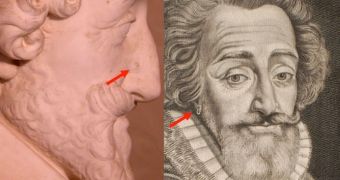About 400 years after King Henry IV of France died, authorities are finally laying his remains to rest. And by that we mean of course his head, which has apparently been making the rounds in private collections of antiquities enthusiasts for centuries.
Back in 1793, as the revolution swept France, revolutionaries symbolically desecrated the tombs of old French kings. On one such occasion, Henry's head was removed from his body and taken away.
Various individuals have since called themselves owners of the relic, until it fell back into the hands of authorities. Yesterday, December 14, it was announced that rigorous analyses had determined that the head – and the brain it contained, too – are indeed the former French monarch's.
The positive identification was made following thorough investigations, which included comparisons of the mummified head with sculptures and portraits of the defunct king.
Researchers even managed to construct a digital model of Henry's face, which matched the one the mummified head carried precisely, LiveScience reports.
A team at the University Hospital R Poincaré in Garches conducted the analysis. Philipp Charlier, a forensic medical examiner and osteo-archaeologist (osteo stands for bones), was in charge of the study.
In a paper published in the December 15 issue of the top British Medical Journal (BMJ), the group explains that the techniques used to identify the former king, who was murdered in 1610, can be used to identify other royal figures as well.
Granted, this approach could in theory be used on any mummified head, so to speak, provided that experts have sufficient historical records or images of the person undergoing the identification process.
“Now positively identified according to the most rigorous arguments of any forensic anthropology examination, the French king’s head will be reinterred in the royal basilica of Saint-Denis after a solemn funeral ceremony,” the researchers wrote in the journal.
In his reigning days, Henry IV was beloved by the French people, even if he had to lay siege to Paris in order to get to the throne. This happened because he was Protestant and France Catholic.
Eventually, after years of rule, he too fell victim to an assassin, echoing the fate of his father, Henry III, who died at the hands of a fanatical monk in 1589.

 14 DAY TRIAL //
14 DAY TRIAL //